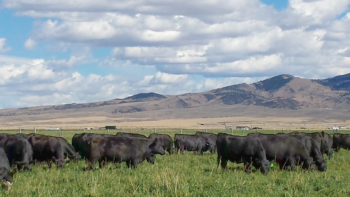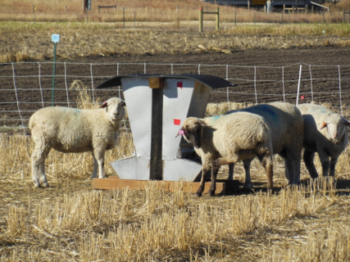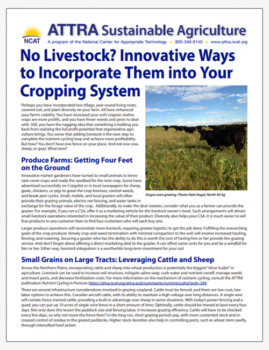No Livestock? Innovative Ways to Incorporate Them into Your Cropping System
By Dave Scott, NCAT Agriculture Specialist

Abstract
Perhaps you have incorporated less tillage, year-round living roots, covered soil, and plant diversity on your farm. All have enhanced your farm’s viability. You have increased your soil’s organic matter, crops are more prolific, and you have fewer weeds and pests to deal with. Still, you have the nagging idea that something is holding you back from realizing the full profit potential that regenerative agriculture brings. You sense that adding livestock is the next step to complete the nutrient-cycling loop and achieve more profitability. But how? You don’t have one fence on your place. And not one cow, sheep, or goat. What now?
Produce Farms: Getting Four Feet on the Ground
Innovative market gardeners have turned to small animals to terminate cover crops and ready the seedbed for the next crop. Some have advertised successfully on Craigslist or in local newspapers for sheep, goats, chickens, or pigs to graze the crop biomass, control weeds, and break pest cycles. Small, mobile, and local graziers will often provide their grazing animals, electric net fencing, and water tanks in exchange for the forage value of the crop. Additionally, to make the deal sweeter, consider what you as a farmer can provide the grazier. For example, if you run a CSA, offer it as a marketing vehicle for the livestock owner’s meat. Such arrangements will attract small livestock operations interested in increasing the value of their product. Diversity also helps your CSA: it is much easier to sell four products to one customer than to find four customers who will each buy one.
Larger produce operations will necessitate more livestock, requiring greater logistics to get the job done. Fulfilling the overarching goals of the crop producer (timely crop and weed termination with minimal compaction to the soil) will involve increased hauling, fencing, and watering. Securing a grazier who has the ability to do this is worth the cost of having him or her provide the grazing service. And don’t forget about offering a direct-marketing deal to the grazier. It can offset some costs for you and be a windfall for him or her. Either way, livestock integration is a worthwhile long-term investment for your soil.
Small Grains on Large Tracts: Leveraging Cattle and Sheep
Across the Northern Plains, incorporating cattle and sheep into wheat production is potentially the biggest “silver bullet” in agriculture. Livestock can be used to increase soil structure, mitigate saline seep, curb water and nutrient runoff, manage weeds and insect pests, and decrease fertilization costs. For more information on the mechanism of nutrient cycling, consult the ATTRA publication Nutrient Cycling in Pastures.
There are several infrastructure considerations involved in grazing cropland. Cattle must be fenced, and there are low-cost, low-labor options to achieve this. Consider aircraft cable, with its ability to maintain a high voltage over long distances. A single wire will contain fence-trained cattle, providing a built-in advantage over sheep in some situations. With today’s power fencing and a quad, you can put up 10 acres of single-wire fence in a short amount of time. Optimally, cattle should be moved at least every four days. Not only does this lessen the paddock size and fencing labor, it increases grazing efficiency. Cattle will have to be checked every few days, so why not move the fence then? In the long run, short grazing periods pay, with more-contented stock and increased control of residue in the grazed paddocks. Higher stock densities also help in controlling pests, such as wheat stem sawfly, through intensified hoof action.

Yearling sheep on wheat stubble in late fall. Photo: Dr. Pat Hatfield, Montana State University
Stock water must be developed or hauled. Development can be a combination of snow, dugouts, and pipeline. Hauling water represents an investment in vehicles and labor. Water is one of the biggest hurdles to getting livestock on cropland.
Sheep are a natural fit for grazing fall or spring stubble, post-crop volunteer residual, and cover crops on large acreages. They offer advantages over cattle through: 1) decreased water consumption; 2) a lighter footprint on the soil due to smaller body size; and 3) reduced need for fencing because, as herding animals, they can be managed by an accompanying herder.
Let’s look at an example using sheep on dryland grain fields in Montana. Similar budgets can be developed for cattle. We can base this example on 1,000 head of yearlings grazing wheat stubble, volunteer vegetation, and then three successively planted (using 10-day planting intervals) cover crops over 120 days (May through August). Based on conversations with some crop farmers and sheep producers, a grazing fee of several to 10 cents per head per day is typical if the cropper can supply water for the sheep through pond dugouts, pipeline, snow, or hauling. The grazier pays for hauling the sheep both ways. In Montana, that is often an 800- to 1,000-mile round trip. The grazier also pays for maintaining the herder, which is approximately $3,000 to $3,500 per month. This includes the herder’s wage, camp tending, and Workers Comp Insurance payments.
In an optimal situation, the crop farmer will be able to supply stock water for the sheep through late spring snow and ponds that last through the grazing period, with little hauling. In this case, $12,000 (120 days @$0.10/head/day for 1,000 head) is expended for the sheep to provide ecosystem services to the cropland. The amount of acres serviced over the season can vary widely, but let’s use an average grazing biomass of 1,200 pounds per acre as a starting point. The 150-pound yearlings will eat about five pounds of dry matter per head per day, a total of 5,000 pounds, which means that they will graze approximately 4.2 acres per day (5,000 pounds of DM/1,200 pounds DM/acre = 4.16 acres). Extending this out further, the sheep will service the acres for an average cost of $24/acre (1,000 sheep X $0.10 per head/4.2 acres = $23.8/acre). These services include terminating a cover crop, performing weed suppression before planting, increasing soil organic matter and fertility through nutrient cycling, and inoculation of soil with beneficial soil microbes. Does $24 an acre represent a positive cost/benefit value for your cropping operation?
There are other possible arrangements. Instead of hiring a herder, the sheep owner could hire a custom operator to care for the sheep and to fence them with temporary electric nets. Using the previous example, four acres would be fenced as a new paddock for the sheep each day. This would require approximately 26 nets (165-foot-long) and a 3-joule solar charger, an investment of about $3,900 that would have a service life of at least five years. In this arrangement, water would have to be hauled daily to the sheep paddocks. The custom operator could move the fence and haul the water with five hours of labor per day. At a total contracted service of $100 per day or $3,000 per month, this could be a summer job for a college student, and the grain farmer would still be inputting $24 per acre for the services the sheep provided.
Alternatively, the crop farmer could buy 60-pound ewe lambs at $2.00 per pound, put 0.50 pounds of daily gain on them by grazing, and sell 120-pound animals at $1.30 per pound. After hauling and fencing or herding costs were subtracted, this could be a profitable venture and still be approximately $24 per acre that the crop farmer would pay.
In each of these examples, costs could be adjusted to suit individual situations. The main take-home point is that sheep can readily provide crop and soil health services with both the crop farmer and sheep producer benefitting.
Need to find livestock? There are several avenues to investigate. First, attend your state’s cattlegrower, wool grower, or goat convention and just start asking to be put in touch with a large producer who has the numbers of livestock that it will take to meet your needs. You can also contact your state Extension sheep or beef specialist for a list of producers. Lastly, there may be a state message board, such as the Montana Sheep Message Board, where you can put out the word of your search for free. Livestock that can do the job are available.
An extension of integrating livestock with cropland is a feedlot on fields. This technique is being investigated by Devon Regan of Montana State University with positive preliminary results. It involves feeding sheep directly on cropland over a portion of the winter, thus gaining nearly 100% control over wheat stem saw-fly infestation and furthering soil health. You bring the feedlot to the animals and leave the nicely distributed manure and urine behind.

Ongoing research at Montana State University is investigating animal gain and soil health aspects of feedlot-finishing lambs on grain stubble. Both high-grain and high-forage diets are being studied. Photo: Devon Regan, Montana State University
You may have to adapt livestock management to meet concerns, such as sheep getting away from the herder. Temporary electric-net fencing is very flexible and cheap at $0.80 per running foot (exclusive of the fence energizer), and this can be used to supplement the herder in sensitive areas adjacent to roads and close to borders with neighbors. Terminating cover crops on larger acreages will require more total sheep (but at the same cost per acre) and may require swathing the cover crop ahead of the sheep to terminate it in a timely manner, to maximize nitrogen release and soil moisture retention (at flowering).
The bottom line is that you don’t have to become a cattle or sheep producer to improve your soil health using livestock. You can treat livestock as a powerful special input that can be employed for a slight cost in comparison to the long-term services these ruminants render. Consider them!
No Livestock? Innovative Ways to Incorporate Them into Your Cropping System
By Dave Scott, NCAT Agriculture Specialist
Published July 2019
IP588
Slot 612
Version 091619


